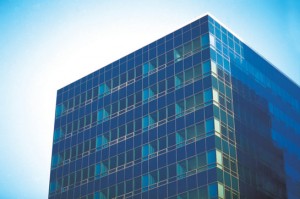
Commercial cooling towers are often found attached to commercial buildings and industrial facilities.
Commercial cooling towers are often found attached to commercial buildings and industrial facilities. Despite the crucial role cooling towers play, many individuals can’t answer common questions regarding their functionality or purpose. For instance, how do they work? What are the most important components in their systems? How can you make them more water and energy efficient? Discover the most important information pertaining to commercial cooling towers.
Types of Commercial Cooling Towers
Cooling towers use air and water together to help cycle cooler air throughout a building. In general, there are two types of commercial cooling towers, which use different mechanisms to achieve their purpose. These types are known as either natural draft or mechanical draft. Mechanical draft cooling towers are usually the smaller of the two towers. Fans are the primary method of creating airflow, and when compared to its counterpart, can be more expensive to use. By contrast, a natural draft cooling tower does not use fans. Instead, the natural draft cooling tower manipulates the air around it and is less expensive to use. Natural draft towers also tend to be larger than mechanical draft towers. Both types of towers contain a component known as film media.
Types of Film Media
There are two types of film media that you will find inside a cooling tower; splash film media and film fill media. Both types of media are intended to increase heat transfer and maximize the effectiveness of the cooling tower. They do this by bringing cool air into contact with hot water. These two components must be brought together to accelerate the cooling process. The longer that hot water is exposed to cool air, the greater the chances for the heat in the water to dissipate. Heat transfer and tower effectiveness are easier to achieve, meaning that the towers don’t have to work as hard. More effective towers also need to have a constant supply of clean water and minimal debris present in the system. Ensuring the clean water and minimizing the amount of debris that enters the system is an important part of maximizing water and energy-efficiency.
Water and Energy-Efficiency
Water conservation is an important part of reducing your building’s environmental impact. By conserving water, you can also make your cooling towers more energy-efficient. Here are some methods for ensuring that your commercial cooling towers are as water and energy-efficient as possible:
- Keep track of water usage through metering.
- Prevent leaks and overflows.
- Consider retrofitting your commercial cooling towers.
- Consider the quality of water in your building’s system.
Crockett Facilities Can Help!
Crockett Facilities Services, Inc. (CFSI) is committed to helping building owners, property managers, engineers, and facility professionals lower their operating expenses through HVAC preventive maintenance. We can develop a cost-effective, customized preventive maintenance plan for your commercial building that will provide you with peace of mind, improved comfort, and energy savings.
To learn more about the importance of HVAC Preventive Maintenance, please contact us at 202.600.2787 or sales@crockett-facilities.com. Our PM contract customers receive priority service with 24/7 emergency service in Maryland, Virginia and Washington, DC.
